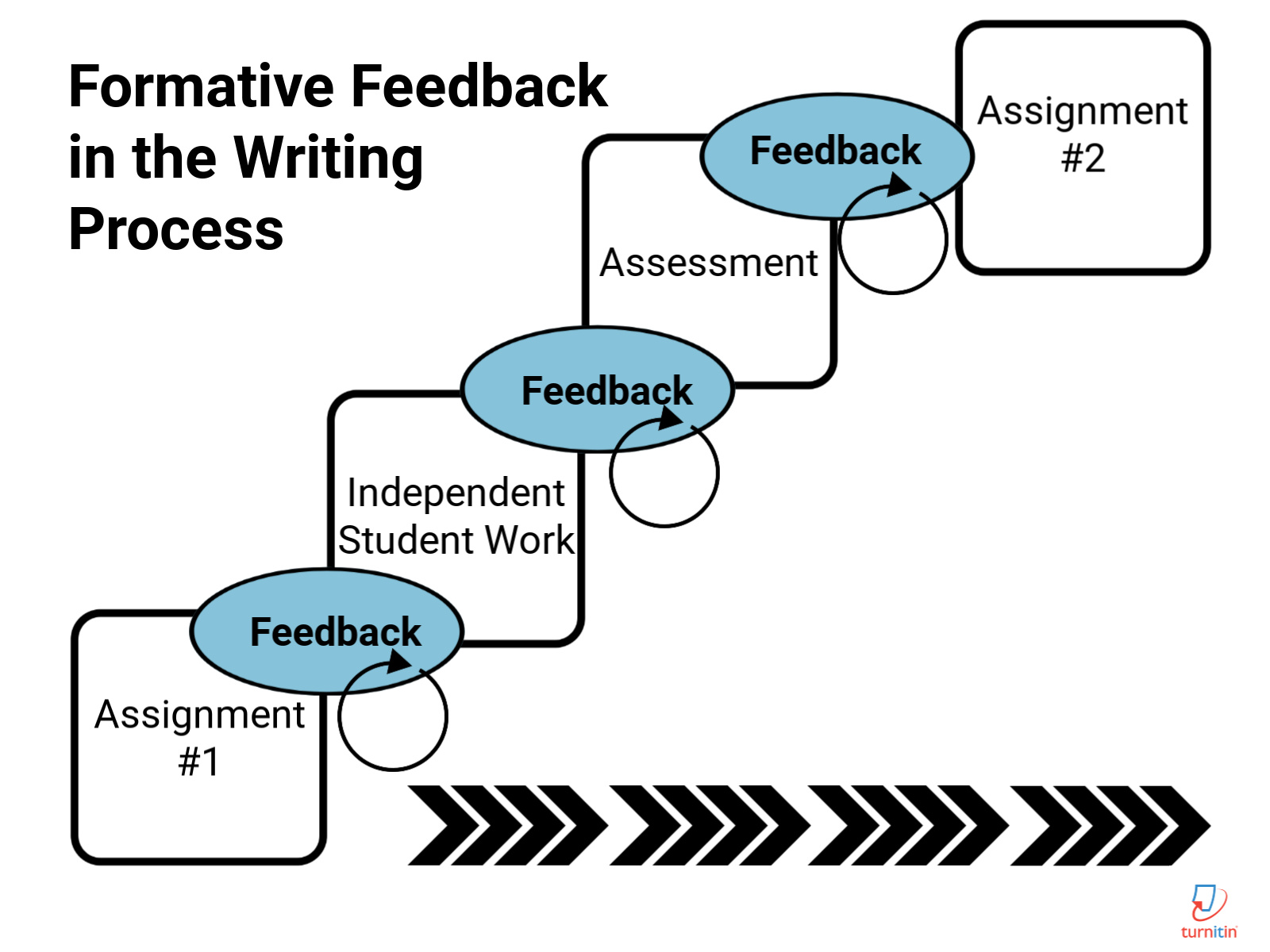Feedback loops are multiple iterations of feedback on student work, where the educator doesn’t just provide ways for the student to improve their work, but also invites them to reflect on the feedback they’ve received.
Feedback loops encourage deeper engagement with a topic as well as metacognition – thinking about thinking – which supports stronger student attainment.
But what exactly do feedback loops involve in practice? How are they different from formative assessment and grading? And how can you implement feedback loops as part of your teaching strategies?
What are feedback loops in education?
Feedback loops are when an educator provides feedback to a student, the student acts on that feedback, and the educator then provides further feedback. It is a cycle that supports continuous improvement and deeper learning.
Consider the following scenarios:
- Tutor 1 sets students an assessment, marks it, and assigns a final grade (typical of summative assessment)
- Tutor 2 sets students an assessment and provides feedback before their final submission (characteristic of formative assessment)
- Tutor 3 sets students an assessment and provides multiple rounds of feedback on several drafts until their final submission (standard in feedback loops)
It’s clear which approach will drive higher subject knowledge, skills development, and long-term retention.
The third scenario – where multiple rounds of feedback are integrated into the learning process – provides students with several opportunities to develop and improve their work, rather than receiving a one-time grade that doesn’t allow them to reflect or grow.

Let’s look at the differences in a little more detail…
Feedback loops vs formative assessment: What’s the difference?
If you’re thinking that feedback loops sound a lot like formative assessment, you’re right. But there is a difference.
Both feedback loops and formative assessments use regular assignments to provide actionable feedback to students. The difference is that feedback loops provide multiple rounds of feedback, whereas formative assessment may only provide feedback once. Plus, feedback loops require students to reflect and report on how they have integrated the feedback into their work, supporting cognitive development.
With formative assessment, students may or may not act on the feedback they’ve been given. With a feedback loop, the instructor has the opportunity to review whether the student has acted on their feedback and to provide further guidance.
As such, a feedback loop provides more opportunities to help students develop their critical skills and subject knowledge.
“Students learned twice as fast when they received constructive feedback (specific comments on errors, suggestions to the students about how to improve, and at least one positive remark) than their peers who simply received a score on their math homework.”
“When feedback is inserted into the drafting and writing process, students can reflect and then apply these concepts in revision and subsequent assignments, creating a self-sustaining feedback loop, separate from the pressure of final assessment.” (Dylan Wiliam, Embedded Formative Assessment , 2011).
In other words, while the impact of formative assessment is highly beneficial in its own right, feedback loops can amplify that benefit by providing more opportunities for reflection and development.
Feedback loops vs summative assessment: the unintended impact of grades
While summative assessment has many benefits – such as benchmarking and assessment at scale – it’s widely acknowledged that a summative approach can stifle student engagement.
According to studies, students shut down their learning after they receive a grade. Dylan Wiliam states:
“Students who only received scores made no progress from one task to the next, while those students who received comments improved about 30 percent.”
He goes on to assert that:
“Students who received both a score and comments also made no progress. The effect of giving them a score had wiped out the benefits of giving them comments.”
Interestingly, even when students received feedback, getting a score alongside it shut down their engagement and motivation.
The implication of Wiliam’s research is clear: if you want to see students improve between tasks, ditch scores and focus solely on feedback.
How do feedback loops support the writing process?
Feedback loops are important in the writing process because they support continuous improvement in student work.
They help the student develop their critical thinking, subject knowledge, research practices, and writing skills on an ongoing basis, by providing feedback throughout the process rather than as a one-off event.
Feedback loops support the writing process by:
- Encouraging critical thinking: By revising drafts based on constructive feedback, students can recognize gaps in their arguments and improve their analysis of the topic. Formative feedback is maximized when it occurs within the writing process, as opposed to at the point of assessment.
- Broadening research: Educators can point out areas for further research or suggest new perspectives for the student to pursue. This iterative process guides them from more superficial to deeper engagement with a subject.
- Promoting metacognition: Effective feedback triggers an ‘inner dialogue [...] and develops awareness of how to apply feedback to future performance by comparing current progress against desired goals’ ( University of Melbourne )
- Improving confidence and resilience: Constructive feedback recognizes effort – not just knowledge – and helps students develop a growth mindset, which can increase their confidence and resilience.
Alisa Barnard, Dean of Studies at the St. Paul’s School in New Hampshire, documented feedback within the writing process , stating that formative feedback allows:
- Real-time reflection on the writing process
- Synchronous and asynchronous feedback
- Access for students too shy to participate in large groups
- A model for collaboration
Collaboration is a key point here. Barnard starts her presentation with a quote from writer and educator Penny Kittle, who states:
“We want students…to write with clarity, voice, and authority… Yet teachers too often act like scolds, red pens in hand… Many teachers spend hours circling errors, expecting that students will work to correct that kind of error in the next assignment… It’s time to stop scolding and start teaching.”
At the heart of the feedback loop approach is a spirit of encouragement and support – where the educator is a trusted guide and the feedback process is something to be embraced – rather than positioning the instructor as someone who criticizes student effort.
By guiding students through a self-directed learning process, feedback loops can bolster student confidence and critical thinking – and this can have implications for academic integrity.
How do feedback loops support academic integrity?
Feedback loops support academic integrity and prevent plagiarism and other forms of dishonesty such as contract cheating.
- Increased engagement: Continuous feedback leads to increased engagement with a topic, with students taking more ownership of their learning, and developing more confidence as they progress. This can reduce the likelihood of students resorting to dishonest conduct.
- Personalized support: Feedback loops deliver personalized, actionable support to students, to help them correct and address issues early on. This extra scaffolding for struggling students can reduce the risk of misconduct.
- Greater transparency: Feedback loops make the writing and critical thinking process more transparent, reducing the opportunity for misconduct.
- Intervention opportunities: Educators develop a stronger understanding of individual students’ knowledge, progress, and writing style, meaning they’re more able to spot inconsistencies that suggest cheating.
If you do become aware of plagiarism, feedback can turn this into teachable moments . However, the ultimate goal is to prevent and deter academic misconduct through well-designed assessment processes.
How can I implement feedback loops in the classroom?
Establish a program of formative assessment – If you don’t already use formative assessment in your course, you’ll need to create a program of regular assessments. This is where your feedback loops will happen. Find out how you can enable formative assessment in your institution .
- Combine positive and constructive feedback: There are two types of feedback, positive and negative (sometimes referred to as feedback and feedforward). Feedback reflects on what students have done well and feedforward makes constructive suggestions for improvement. Use a combination to maintain engagement.
- Give specific, actionable feedback: To be useful to students, feedback needs to be specific. Avoid generic feedback like ‘Well done’ or ‘Needs work’. Be clear about what’s working and what isn’t – for example, structure, argument, grammar, etc. Consider providing a checklist summary at the end of the feedback for students to work through.
- Allow time for revision: Students need time to reflect and act on your feedback so don’t rush them for their next iteration. Providing reasonable deadlines also reduces the risk of academic misconduct.
- Encourage metacognition: Metacognition is thinking about thinking. After each round of feedback, ask the student to reflect on what they learned from the feedback and how they felt it improved their work.
- Review the revisions: One of the main points of a feedback loop is to assess whether the student has effectively actioned your feedback. On future drafts, make sure you feedback on how well the student has responded to your initial comments. Remember to praise improvements to encourage ongoing engagement.
- Create a psychologically safe space: To prevent students from disengaging, create an environment where they feel comfortable receiving constructive feedback and develop a growth mindset. Recognize and reward effort alongside achievement, and normalize the process of iteration and improvement.
- Use technology to support feedback processes: Providing feedback at scale can be challenging but technology can help. Explore tools like Turnitin Feedback Studio to automate some of the process and make more time for 1-2-1 relationships.
Final thoughts and key takeaways
Integrating feedback loops into formative assessment not only helps students achieve better outcomes, it can also reduce instances of academic misconduct by bolstering student confidence and reducing opportunities for misconduct.
Turnitin Feedback Studio equips educators to create formative learning opportunities, some of which are entirely hands-off, such as unlimited submissions and Draft Coach – to help students create their best, original work.





